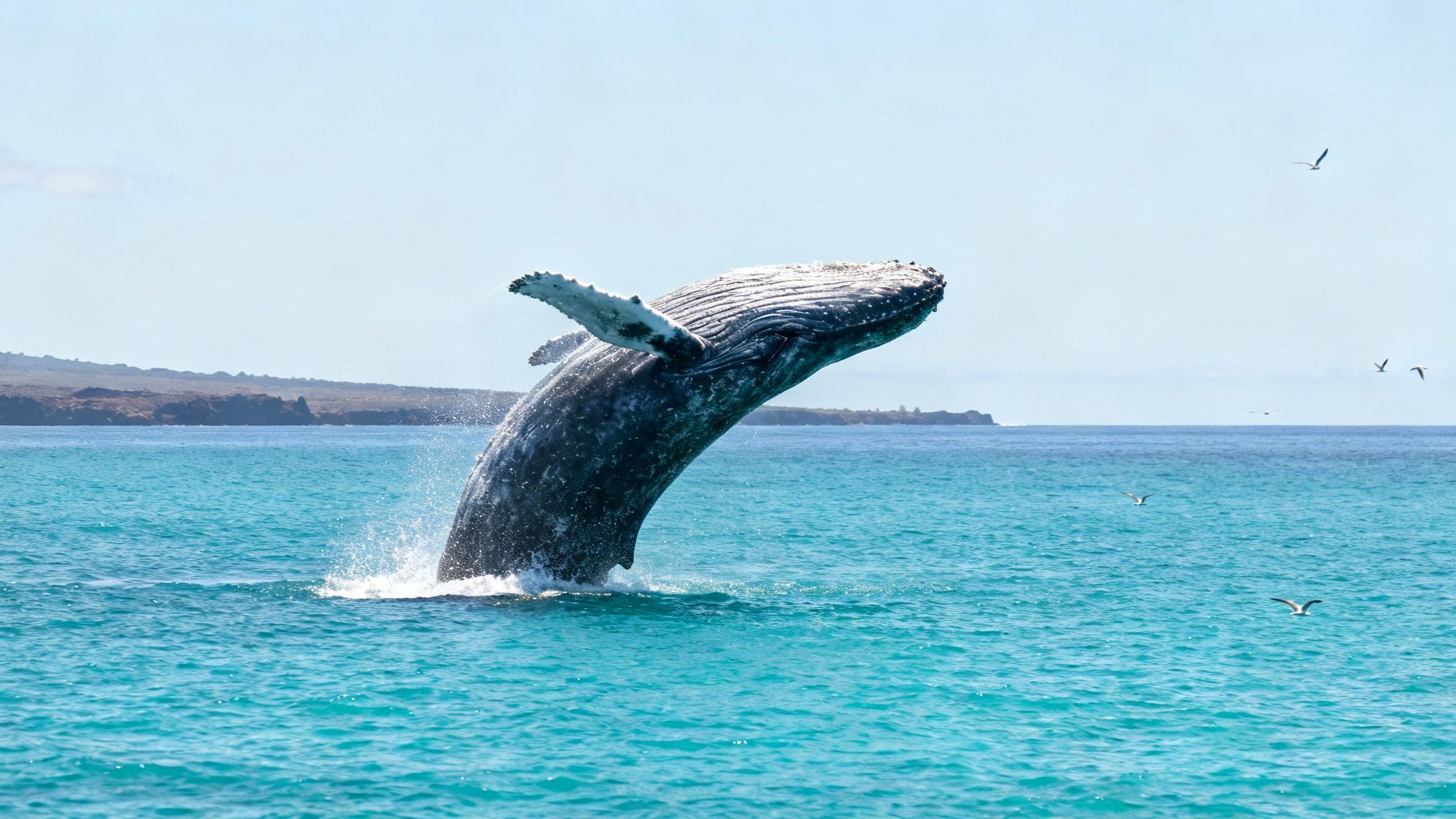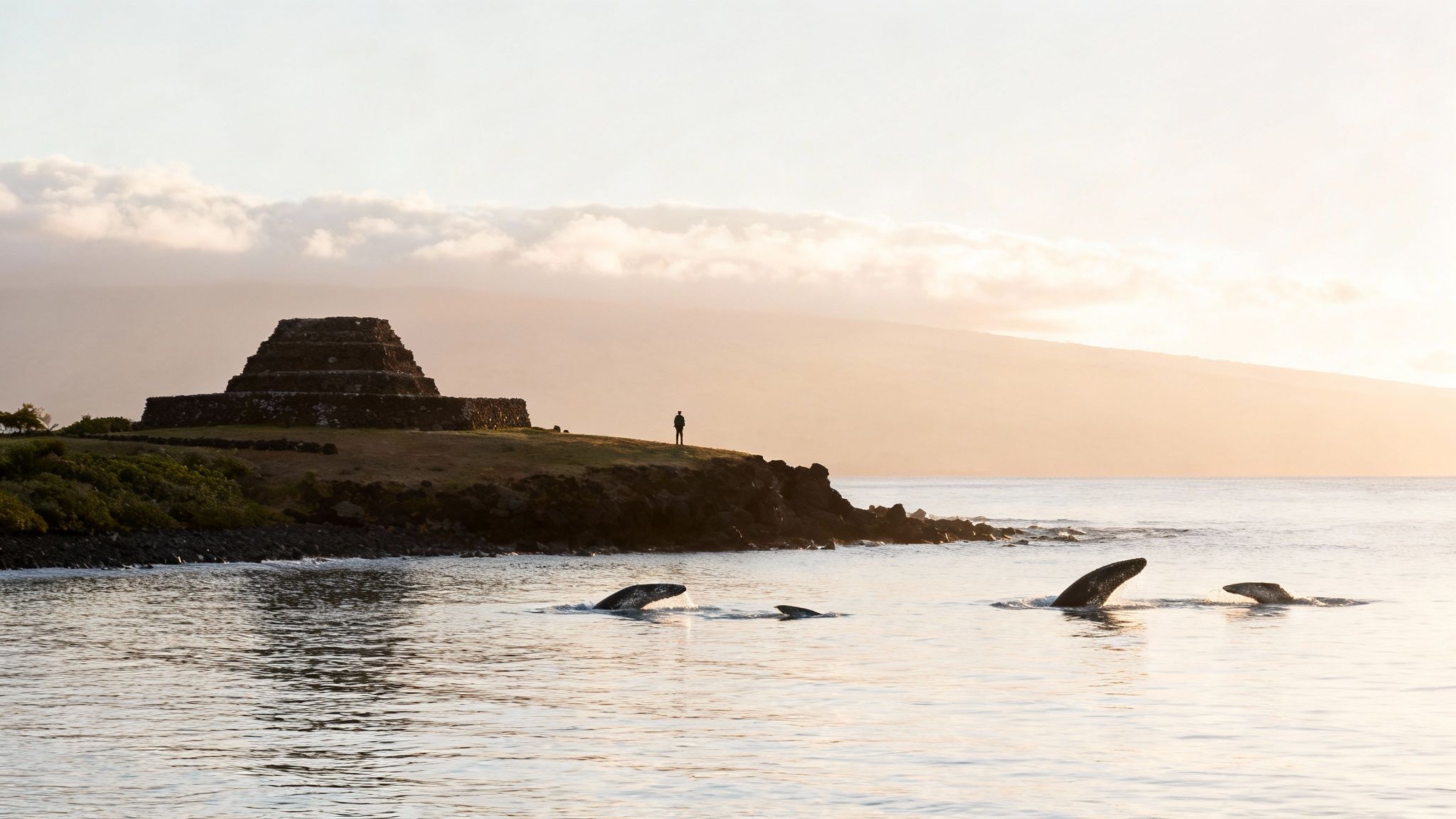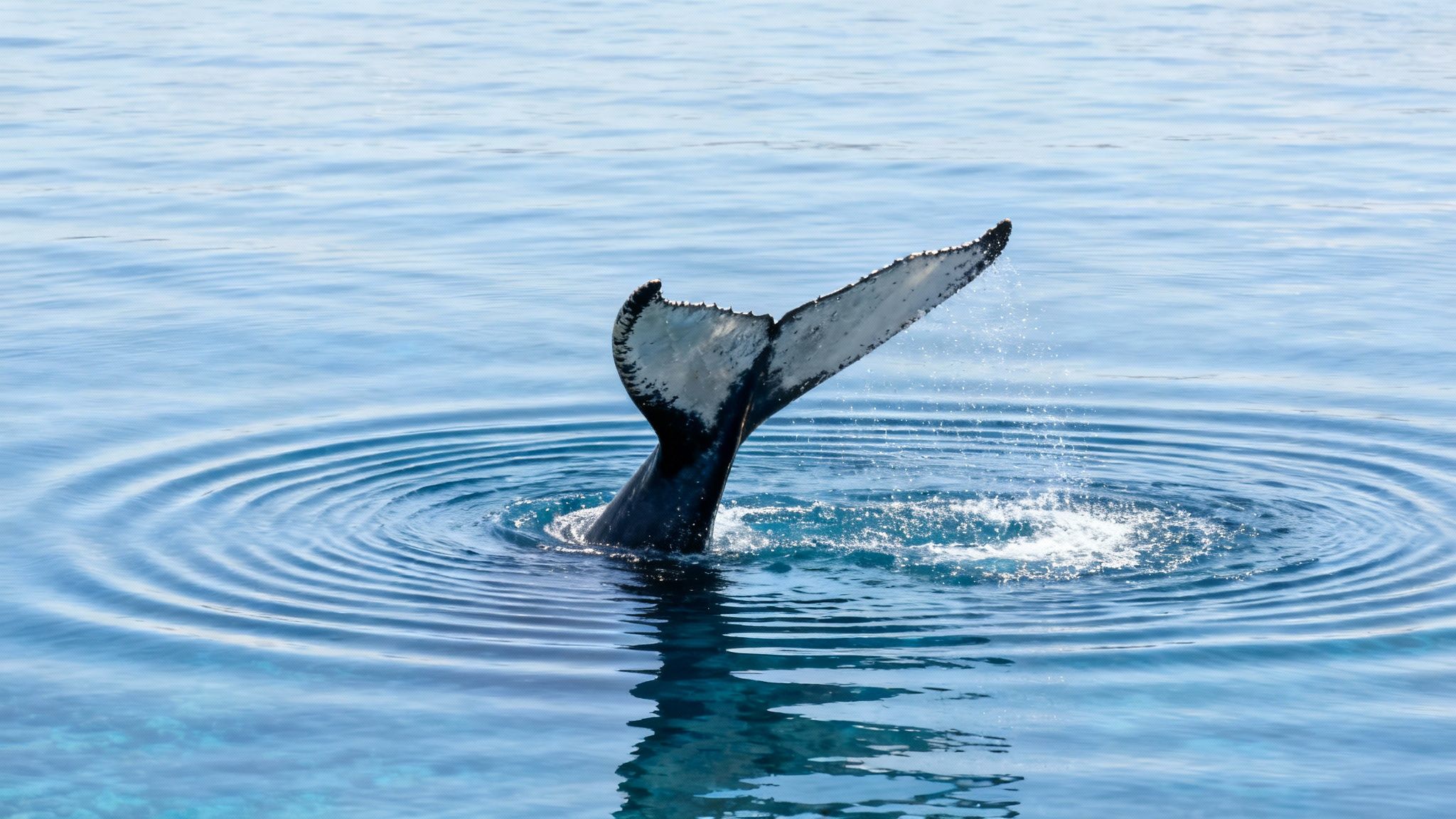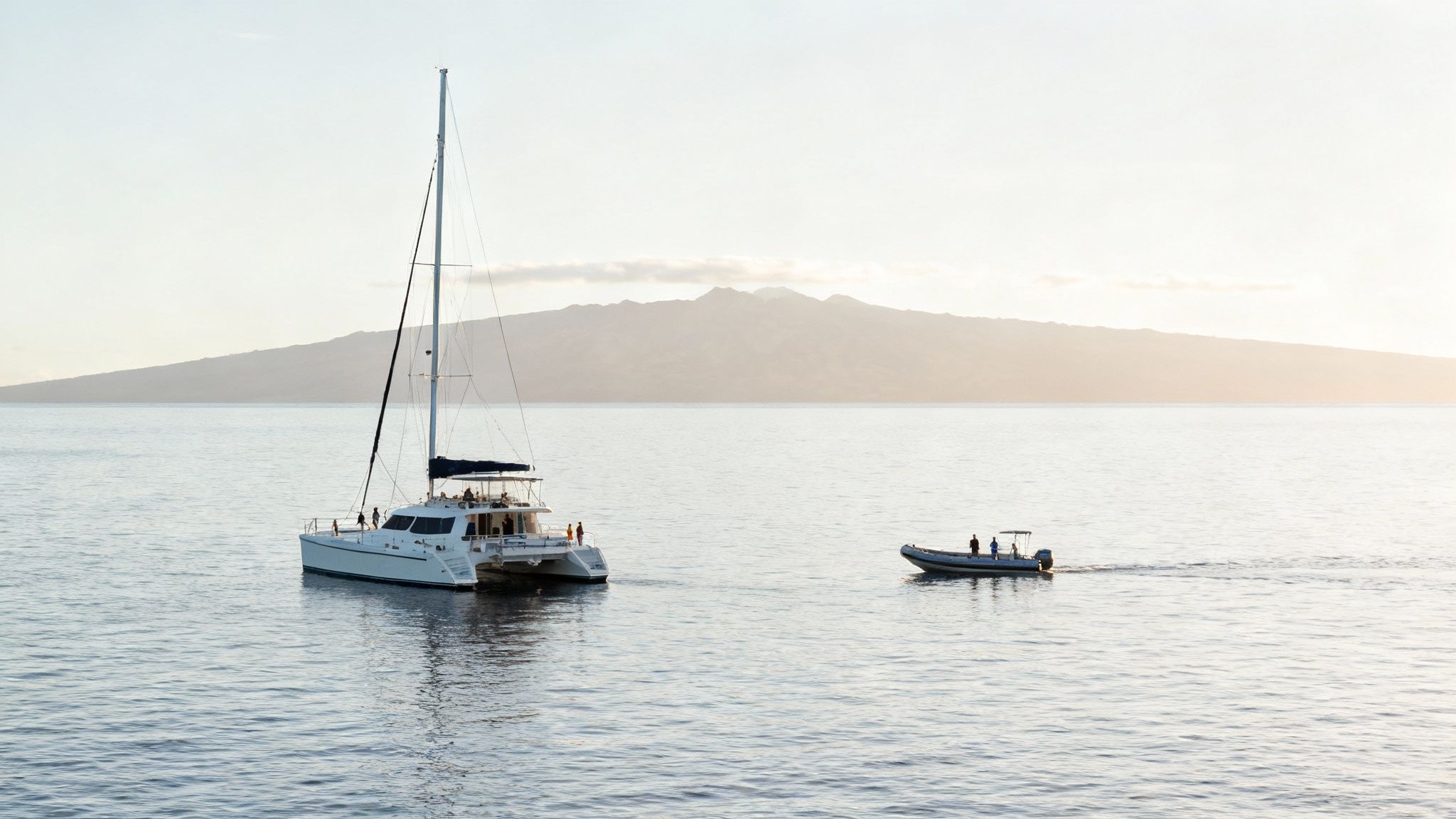Discover whale watching hawaii big island: A Quick Guide

Imagine the Pacific’s turquoise expanse erupting as a 40-ton humpback whale catapults itself skyward. Not a nature documentary—just a regular moment on Hawaii’s Big Island during peak whale watching season. This guide walks you through everything you need to know to turn that once-in-a-lifetime sighting into reality.
Why Hawaii Is A Whale Watching Paradise
Every winter, the Big Island becomes a haven for one of nature’s greatest migrations. Seeing these giants breach feels like front-row seats to a living, breathing ocean ballet. As the top rated & most reviewed snorkel company in Hawaii, Kona Snorkel Trips prides itself on crafting adventures that honor both wildlife and guests.

An Epic Journey To The Islands
The saga of whale watching hawaii big island is a testament to conservation in action. After plummeting to the brink, the Pacific humpback population has rebounded to around 26,000 whales. Each year, thousands embark on an arduous 3,500-mile trek from Alaska’s icy shores to Hawaii’s warm embrace. Curious how they made this comeback? Learn more about their migration journey and population recovery.
These sheltered Hawaiian bays are more than a pit stop—they’re a nursery, classroom, and arena all in one:
- Birthing: Mothers choose calm coves to bring calves into the world.
- Nursing: Tiny newborns, with minimal blubber, rely on the toasty waters to fuel rapid growth.
- Mating: Rival males stage dramatic displays, vying for attention with flips, dives, and songs.
Thanks to this annual pilgrimage, every voyage teems with possibility. And while humpbacks steal the show, keep your eyes peeled—you might also catch a glimpse of a dolphin mid-leap over crystal clear ocean waters.
More Than Just Whales
The Big Island’s marine world is a grand stage. Beyond the breaching giants, you’ll often spot:
- Playful spinner dolphins darting through the swell
- Gentle sea turtles cruising along lava reefs
- Vibrant schools of tropical fish weaving among coral
For planning that next-level excursion—mixing wildlife encounters with a dash of history—check out our guide to wildlife watching and historical sightseeing tours.
https://konasnorkeltrips.com/wildlife-watching-historical-sightseeing-tour/
When and Where to See Whales on the Big Island
Timing is everything when you're hoping to witness Hawaii's most magnificent visitors. If you want to maximize your chances of seeing the breathtaking breaches and tail slaps of humpback whales, you've got to be here when they are. It’s like having an all-access pass to one of the greatest shows on Earth.
The prime viewing window swings open in mid-December and stretches through March. But if you’re after the real peak of the action—the highest concentration of whales, with the most surface activity and plenty of mother-calf pairs—you absolutely want to aim for January and February. During these two months, the waters off Kona are simply electric with activity.

To help you get your timing just right, we've put together a quick cheat sheet for planning your Big Island whale watching adventure.
Big Island Whale Watching At a Glance
| Factor | Best Option | Why It's Best |
|---|---|---|
| Peak Season | January & February | This is when you'll find the highest density of humpback whales, meaning more frequent and spectacular sightings. |
| Viewing Area | Kohala Coast | Its calm, protected waters are a magnet for mothers and calves, offering unparalleled viewing opportunities away from strong winds. |
| Land-Based Spot | Puʻukoholā Heiau | This historic site, whose name literally means "hill of the whale," provides an incredible elevated vantage point over the ocean. |
| Time of Day | Early Morning | The ocean is typically calmer, creating a glassy surface that makes spotting a whale's spout against the horizon much easier. |
This table gives you the essentials, but let's dive a bit deeper into why these spots and times are the absolute best for an unforgettable experience.
The Kohala Coast: The Premier Viewing Area
While you can technically spot whales from almost anywhere around the island, not all coastlines are created equal. The undisputed champion for whale watching is the Kohala Coast, which runs along the northwestern side of the Big Island. Its unique geography creates a calm, protected sanctuary that migrating humpbacks seem to love.
And it’s not just a hunch—the data backs it up. Scientific research consistently shows the Kohala Coast has the highest concentration of humpback whale sightings, sometimes two to three times higher than other areas. By March, however, sighting frequencies can drop by about 50%, which is why hitting that January-February window is so important.
This calm environment is precisely why experienced guides and researchers head here. The gentle seas don't just attract the whales; they make for a much more comfortable and successful trip for everyone on board. For a full rundown of what to expect each month, check out our detailed guide to the Big Island whale watching season.
Land-Based Viewing Hotspots
You don’t always need a boat to see the magic happen. For those who prefer to keep their feet on solid ground, the Big Island has some fantastic shoreline spots, especially along that same famed Kohala Coast. The trick is to find an elevated perch that gives you a wide-open view of the ocean.
Here are a few of our favorite spots for land-based whale watching:
- Puʻukoholā Heiau National Historic Site: The name translates to "hill of the whale," and it definitely earns it. The site offers sweeping ocean vistas that are perfect for spotting distant spouts and breaches.
- Lapakahi State Historical Park: This park is another excellent choice, providing a great high-up viewpoint over the calm, protected waters where whales often linger.
- Kapaʻa Beach Park: A solid option with the added bonus of shaded picnic areas, so you can scan the horizon for hours in comfort.
A pro tip for watching from shore: go in the early morning. The ocean surface is often like glass, making it far easier to spot that tell-tale puff of a whale's spout on the horizon.
Decoding Humpback Whale Behavior
There’s nothing quite like spotting a 40-ton humpback breach the surface. That heart-pounding moment sticks with you. But once you start to unravel the meaning behind each splash and slap, whale watching becomes a lesson in connection.

These ocean giants aren’t just showing off; every move carries purpose. From sending messages to easing itchy barnacles, their actions reveal a rich social life beneath the waves.
The Most Iconic Whale Actions
When you’re bobbing on the deck of your Whale Watching Hawaii Big Island tour, you’re essentially eavesdropping on an underwater conversation. Here are the behaviors you’re most likely to see—and what they tell us:
-
Breach: A full-body launch into the air.
Scientists think it washes off barnacles, advertises presence, and maybe even feels good. It’s part power move, part playful celebration. -
Tail Slap (Lobtailing): A thunderous fluke-to-water thwack.
That boom travels for miles underwater—often a warning or a “Hey, I’m here” broadcast to other whales. -
Pectoral Fin Slap: A sideways roll followed by repeated fin-to-water smacks.
Similar to a tail slap, this rhythmic pattern helps whales coordinate with their pod.
A spy-hop is pure curiosity. The whale lifts its head straight up, peering around like a sentry. Suddenly, you feel just as watched as the whale is watching you.
The Haunting Songs Of The Humpback
Below the surface drama lies an even richer soundscape. Only male humpbacks belt out these songs, and they can stretch beyond 20 minutes.
Each melody features repeating themes that shift subtly with each season—like an evolving soundtrack to the migration. While their exact role remains a bit of a mystery, most researchers link these suites of notes to mating rituals.
On calm days, you can drop a hydrophone over the side of the boat and listen to this amazing symphony firsthand.
The fact that these whales have bounced back from near-extinction is one of the great conservation victories. Every breach, slap, and song you witness is proof of a healthy population. To dive deeper into their comeback, check out what it meant when humpback whales were delisted from endangered status.
Choosing Your Ideal Big Island Whale Watching Tour
Picking the perfect tour is what turns a good day on the water into an unforgettable one. With so many options out there for whale watching hawaii big island, it can feel a little overwhelming. Let's break down the choices to make sure your adventure is safe, respectful, and absolutely magical.

The kind of boat you're on really sets the tone for the whole experience. Every vessel gives you a different angle on these incredible animals, and what's "best" really comes down to your group and what you're looking for.
Comparing Vessel Types
Think of it like choosing between a comfortable tour bus and a zippy off-road jeep. A big, roomy catamaran offers a super stable ride, plus amenities like restrooms and plenty of shade. This makes it a fantastic choice for families with small kids or anyone who gets a little wobbly on the water. The only trade-off is you'll likely be sharing the view with a larger group.
On the other hand, a smaller zodiac-style raft gets you right down at water level for a much more intimate feel. These boats are faster, can cover more ocean, and usually carry fewer people, which makes for a really personal and thrilling trip. Just know that they offer less protection from sun and spray and can be a bumpier ride—perfect for the adventure-seekers in your crew.
The best tour isn't just about the boat; it's about the philosophy of the crew. A responsible operator understands that we are guests in the whales' home and acts with profound respect.
Finding a Responsible Tour Operator
Who you go with matters. A lot. A great company doesn't just chase down whales; they're passionate about protecting them. The best operators are all-in on marine conservation and stick to the federal regulations like glue, which means staying at least 100 yards away from humpback whales.
Keeping that respectful distance is so important for the whales' well-being, especially for new moms and their calves. A skilled captain knows exactly how to position the boat for incredible views without ever stressing the animals.
When you're looking to book, here are a few key questions to ask to make sure you're choosing an ethical company:
- What is your group size? Smaller groups almost always mean a more personal experience for you and a less intrusive one for the whales.
- Do you have a naturalist on board? Having an expert guide along can turn a simple sighting into a fascinating learning experience.
- How do you practice responsible whale watching? A good company will be excited to tell you all about how they follow guidelines and protect the ocean.
- What is your success rate for sightings? In the peak of the season, an experienced crew should have a pretty high success rate.
Here at Kona Snorkel Trips, our seasonal whale watching tours are built around a small-group philosophy. This ensures every encounter is personal, respectful, and something you'll remember forever. We put the whales' welfare first, which allows for those truly natural, awe-inspiring moments. To get a better feel for our approach, you can learn more about our premier Kona whale tours. When you choose a company that shares your values, you're not just having an adventure—you're helping protect these magnificent ocean giants.
How to Be a Responsible Whale Watcher
Watching a forty-ton humpback whale explode out of the ocean is something you never forget. It's a raw, powerful, almost spiritual moment. And with that incredible privilege comes a serious responsibility to protect these gentle giants. They’ve traveled thousands of miles to get here, seeking the warm, safe Hawaiian waters to give birth and raise their calves. How we act on the water has a direct impact on their survival.
Luckily, being an ethical whale watcher isn't complicated. It really just boils down to being a good houseguest. The single most important rule is simple, and it's backed by federal law: stay at least 100 yards away from humpback whales. That goes for every single vessel out there, from big tour boats to the smallest kayak or paddleboard.
Why the 100-Yard Rule Matters So Much
Think about it from their perspective. Imagine you're a new mom trying to rest and nurse your newborn. The last thing you'd want is a bunch of strangers constantly getting in your face, making noise, and causing stress. That's exactly what it's like for a mother humpback and her calf. They're here to rest, nurse, and help that baby build up the strength for the exhausting swim back to Alaska.
The 100-yard buffer zone is more than just a number—it’s a giant "Do Not Disturb" sign for one of the most important whale nurseries on Earth. It gives them the space they need to be whales, without feeling harassed or threatened.
Any professional, responsible tour operator gets this. They will never, ever chase down a whale or crowd a pod just for a closer look. A truly skilled captain knows how to position the boat at a safe, respectful distance, often cutting the engines entirely. They let the whales decide. If the gentle giants are feeling curious, they might just come over to check you out on their own terms. This is why choosing a tour that puts the whales' well-being first, like our seasonal Kona whale watching tours, is so critical to having a truly positive encounter.
The Hawaiian Islands Humpback Whale National Marine Sanctuary
The waters around the main Hawaiian Islands are so critical to the humpback population that they’ve been designated as the Hawaiian Islands Humpback Whale National Marine Sanctuary. This isn't just a name; it’s a protected status that highlights just how vital this habitat is for the species' survival. The sanctuary is dedicated to protecting the whales and their environment through ongoing research, education, and getting the community involved.
And you can be part of that effort! Community-based science programs are a huge help in keeping track of the humpback population. For instance, the annual Sanctuary Ocean Count has been empowering volunteers since 1996 to collect data right from the shoreline. During a recent count, an amazing 429 volunteers tallied a grand total of 2,121 whale sightings in a single day across the islands. By choosing responsible tour operators and supporting these conservation efforts, you shift from being just a tourist to becoming a true steward of the ocean.
Your Whale Watching Questions Answered
Stepping aboard a whale watching Hawaii Big Island excursion sparks excitement from the moment you arrive at the dock. To set you up for success, we’ve rounded up the questions we hear most often—and shared the insider tips that turn a good day on the water into an unforgettable one.
Whether you're curious about what to pack or how to stay safe while respecting these gentle giants, this guide will walk you through everything you need to know before you cast off.
What Should I Bring On A Whale Watching Tour
Ocean conditions can shift in a heartbeat, so think of your packing list like preparing for a mini outdoor expedition. A light daypack with these essentials will keep you comfortable—and ready for anything:
- Sun Protection: Hawaiian rays intensify over water. Bring reef-safe sunscreen, a wide-brimmed hat, and polarized sunglasses to shield your skin and cut glare so you can spot blows on the horizon.
- Layered Clothing: Even sunny mornings can turn breezy once you’re offshore. A lightweight, waterproof jacket stashed in your bag takes up little room but makes a big difference.
- Camera And Binoculars: You’ll want proof of that first spout or breach. Charge batteries fully, and don’t forget binoculars for a detailed view when whales surface farther away.
- Motion Sickness Remedies: If you tend to feel queasy, plan ahead. Over-the-counter or prescription remedies—taken as directed—mean you’ll spend the day marveling, not queuing for the rail.
Is A Whale Sighting Guaranteed On A Tour
We wish we could promise every trip comes with a whale cameo, but these are wild animals—and they roam. Still, peak season on the Big Island (January–February) delivers an astonishing 95% success rate with experienced captains at the helm. Here’s the reality check:
- Sightings are never 100% guaranteed, but…
- Most reputable operators track pods and migration patterns closely.
- Many offer a “sighting guarantee,” letting you rebook for free if you see no whales.
Before you reserve, ask about the company’s policy—knowing the fine print ensures you’re not left empty-handed.
Can I See Other Marine Life Besides Whales
Absolutely. While humpbacks steal the spotlight, the Pacific around the Big Island is a thriving underwater metropolis. Keep your eyes peeled for:
- Playful Spinner Dolphins showing off acrobatic flips
- Curious Bottlenose Dolphins weaving alongside the boat
- Graceful Green Sea Turtles (honu) gliding near the surface
- A variety of seabirds—frigatebirds, terns, and boobies—diving for their next meal
“While you’re scanning the horizon for that telltale spout, a pod of dolphins might suddenly peer up beside your bow, stealing the show.”
Your onboard naturalist will point out each guest star, weaving fascinating facts into the moments you spend floating on the blue expanse.
How Close Can We Get To The Whales
Keeping a respectful distance is more than etiquette—it’s the law. Federal regulations in Hawaii require staying at least 100 yards (roughly a football field) from humpbacks, especially when mothers and calves are nearby.
Ethical captains will slow down as they drift into the whales’ path and cut engines, letting curious whales—and sometimes inquisitive calves—decide how close they want to venture. This patient approach leads to the most genuine encounters and ensures we protect these magnificent creatures for generations to come.
For an authentic, up-close experience—minus the overcrowded decks—hop on one of our small-group whale watching tours with Kona Snorkel Trips. With fewer people on board, you’ll enjoy personalized attention and a front-row seat to nature’s greatest show. Book today and see why our guests say it’s the highlight of their Big Island adventure. Learn more about our Kona whale watching tours.
